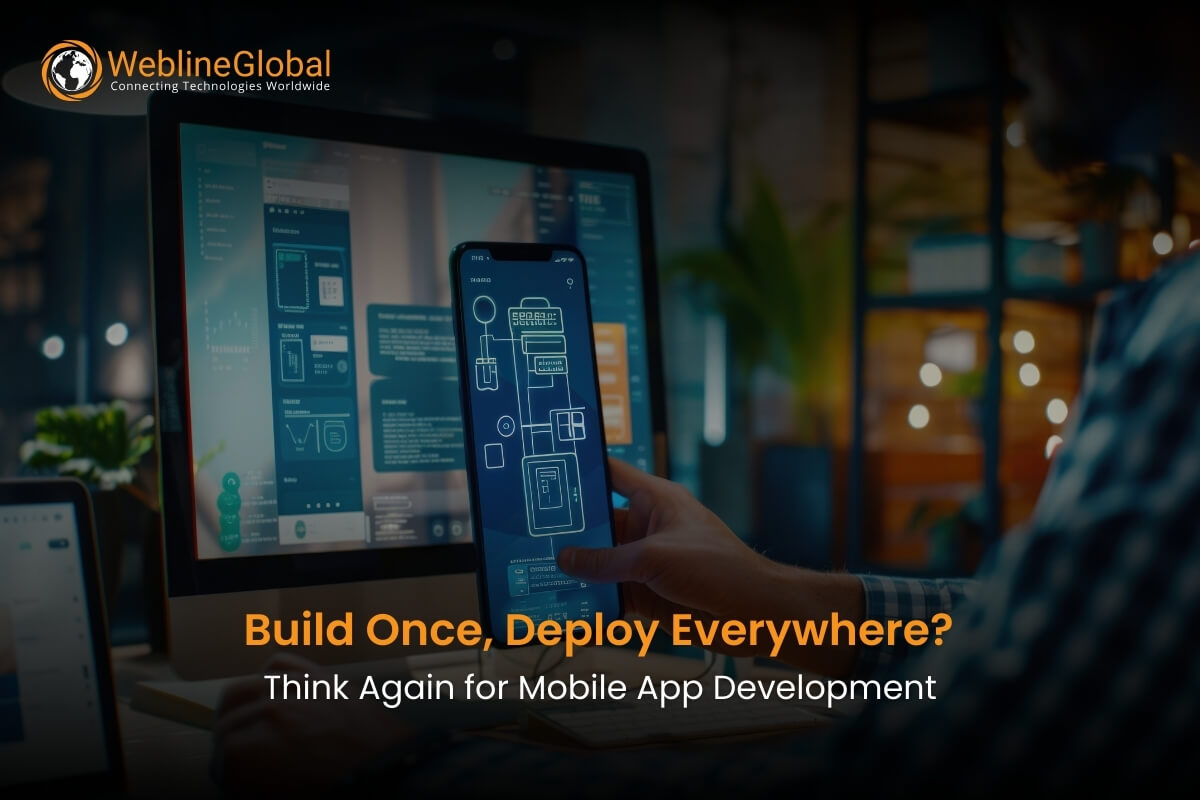
In the world of mobile app development, the concept of “Build Once, Deploy Everywhere” (BODE) has been a focal point of discussions for years. Developers dream of writing a single codebase that seamlessly runs across multiple platforms, including iOS, Android, and web applications, with minimal effort and maximum efficiency.
The rise of advanced technologies and cross-platform frameworks has made this dream closer to reality than ever before. Frameworks like Flutter and React Native are pushing the boundaries of what’s possible, allowing developers to significantly reduce the time and cost involved in creating applications for multiple platforms.
This blog explores how the myth of “Build Once, Deploy Everywhere” is no longer just a myth. It’s now a practical reality thanks to powerful tools like Flutter, React Native, and other modern technologies. We’ll also dive into why you should hire WeblineGlobal developers to get high-performance, scalable apps for iOS, Android, and even web platforms—using a single codebase.
Building for iOS, Android, and Web and wondering if one codebase is enough for all platforms?
The Evolution of Cross-Platform Development: From Myth to Reality
Cross-platform development has undergone a remarkable transformation over the years. In the early days of mobile app development, businesses had to invest in separate codebases for iOS and Android, leading to increased costs, longer development cycles, and inconsistent user experiences. Hybrid frameworks like PhoneGap and Xamarin attempted to bridge this gap but often fell short in delivering native-like performance and feel.
- Early Attempts and Their Limitations: Early cross-platform approaches, often relying on web-based technologies, struggled to deliver native-like performance and UI/UX. This highlighted the need for more sophisticated solutions.
- The Need for Native Performance and UI: App developers recognized the importance of native performance and platform-specific UI to ensure a seamless user experience. This demand fueled the development of frameworks that could bridge the gap between cross-platform development and native capabilities.
- The Rise of Modern Cross-Platform Frameworks: Frameworks like React Native and Flutter emerged as game-changers, offering near-native performance, native UI rendering, and access to device-specific features.
The Triumph of ‘Build Once, Deploy Everywhere’ BODE: A New Era for Mobile Development
The advancements in cross-platform frameworks like Flutter and React Native have solidified ‘Build Once, Deploy Everywhere’ as a viable and efficient strategy for custom mobile app development. It’s no longer a myth but a proven methodology.
- Cost-Effectiveness: ‘Build Once, Deploy Everywhere’ significantly reduces development costs by eliminating the need to maintain separate codebases for each platform.
- Accelerated Development Cycles: BODE streamlines the development process, enabling faster time-to-market and quicker iterations.
- Consistent User Experience: BODE ensures a consistent user experience across platforms, strengthening brand identity and user loyalty.
Data Science Society published some key facts and statistics about cross-platform development. The cross-platform app development market was projected to surpass $546.7 billion in 2033. This approach to development offers significant cost savings, reducing expenses by nearly 40%. Additionally, cross-platform development can halve the time required to build an app and allow developers to reuse approximately 80% of the code for different platforms.
Why “Build Once, Deploy Everywhere” is Now Achievable?
Today, the landscape has changed dramatically. Modern frameworks like Flutter and React Native have redefined what’s possible, enabling developers to write a single codebase that runs flawlessly across multiple platforms. These tools have matured to a point where they not only match the performance of native apps but also offer a seamless development experience.
To summarize:
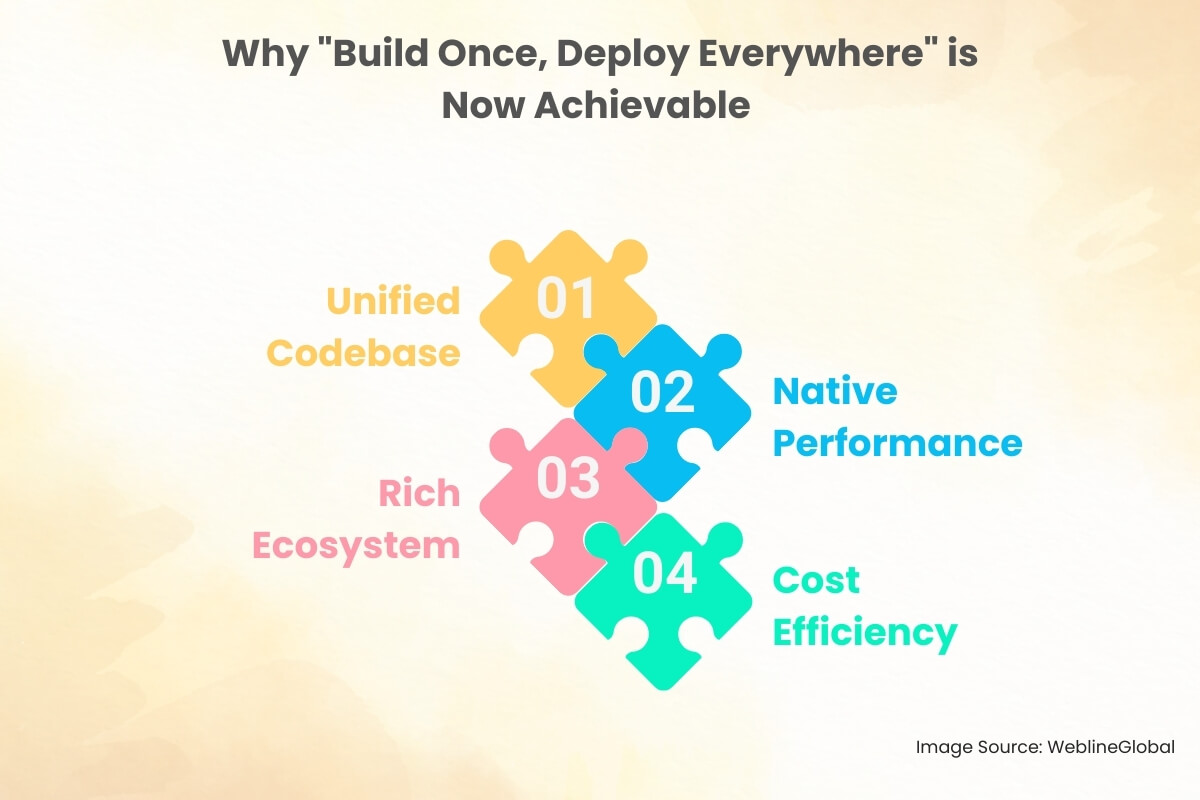
- Unified Codebase: Frameworks like Flutter and React Native allow developers to write one codebase that can be deployed across iOS, Android, and even the web. This eliminates the need for platform-specific development, saving time and resources.
- Native Performance: Unlike older hybrid frameworks, modern tools compile to native code, ensuring that apps deliver performance comparable to those built with platform-specific languages like Swift or Kotlin.
- Rich Ecosystem: Both Flutter and React Native boast extensive libraries, plugins, and tools that simplify development and enable developers to implement complex features with ease.
- Cost Efficiency: By reducing the need for separate development teams for each platform, businesses can significantly cut down on development costs while still delivering high-quality apps.
Looking for a Faster, Cost-Effective Mobile Solution for Your Business?
React Native and Flutter to Empower the ‘Build Once, Deploy Everywhere’ Paradigm
React Native and Flutter have redefined the cross-platform landscape, making BODE a practical and efficient approach. According to a 2023 developer survey published on Statista, Flutter has emerged as the leading cross-platform mobile framework among global developers. The survey further revealed that 46% of software developers utilize Flutter.
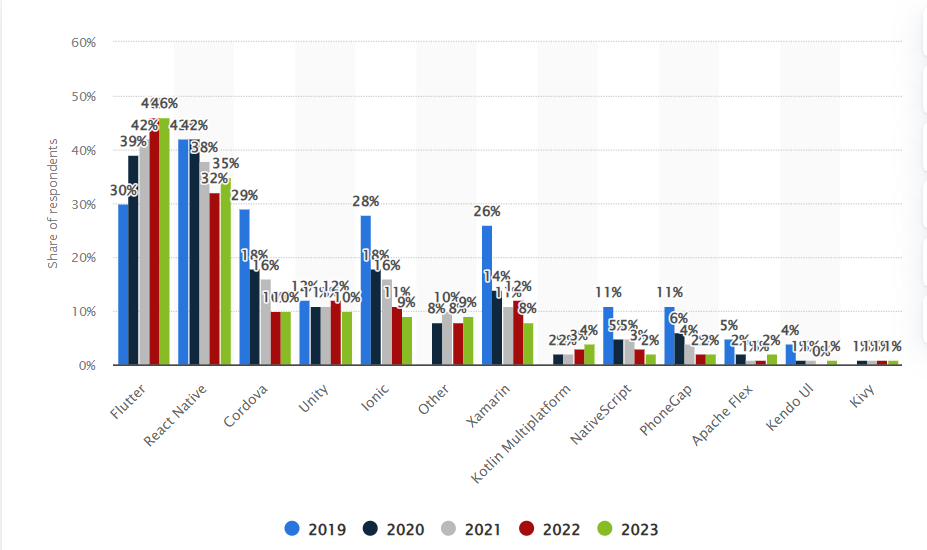
Source: Statista on Worldwide Cross-Platform Development
Overall, about one-third of mobile developers prefer cross-platform technologies or frameworks, while the remaining developers opt for native tools. These frameworks empower developers to create high-quality apps with a single codebase.
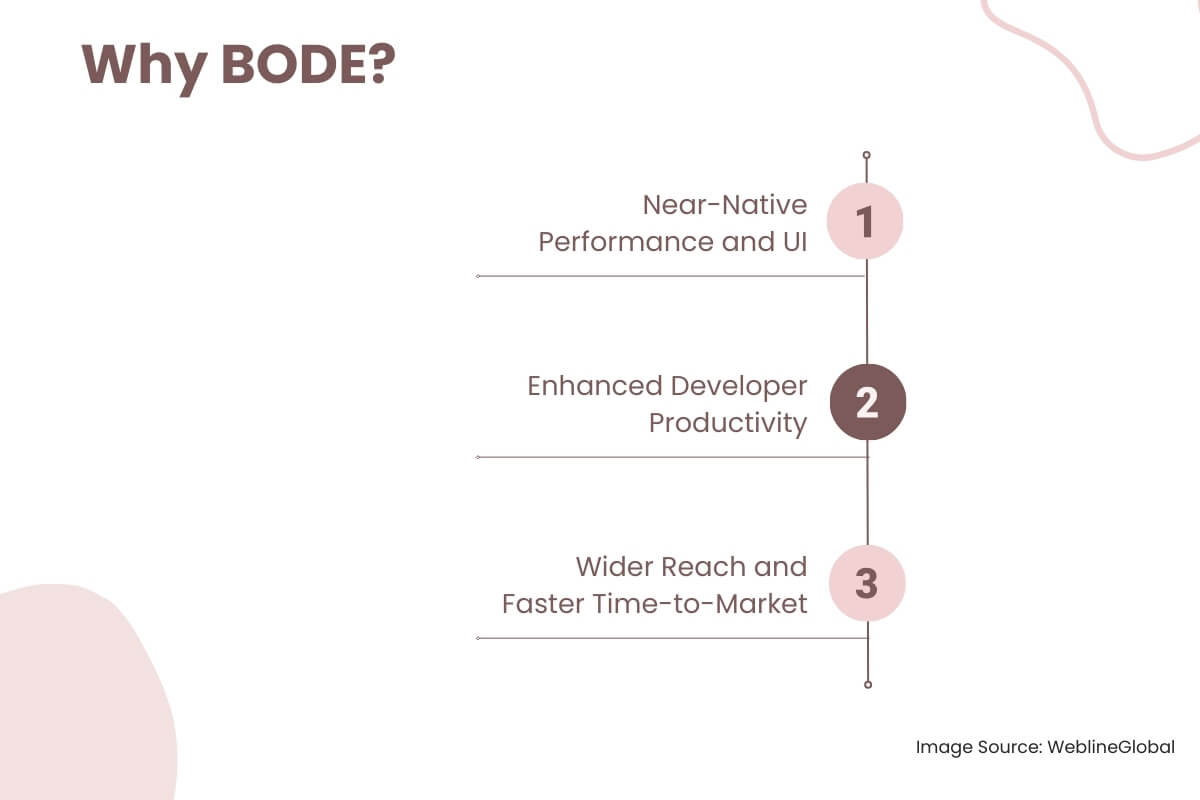
- Near-Native Performance and UI: Both React Native and Flutter compile code into native instructions, resulting in performance comparable to native apps. They also facilitate the creation of platform-specific UI elements, ensuring a consistent and familiar user experience.
- Enhanced Developer Productivity: BODE significantly reduces development time and effort. Developers can focus on building core app logic and features, rather than rewriting code for each platform.
- Wider Reach and Faster Time-to-Market: With BODE, businesses can reach a broader audience by deploying their apps on multiple platforms simultaneously, accelerating time-to-market and maximizing ROI.
Let us now take a look at two major cross-platform app development technologies.
Flutter is a Powerful Toolkit for Cross-Platform Success
Flutter, developed by Google, has gained rapid traction due to its exceptional performance, developer-friendly features, and rich ecosystem. Flutter app development helps businesses achieve better efficiency and productivity. It empowers developers to build beautiful and performant apps for various platforms.
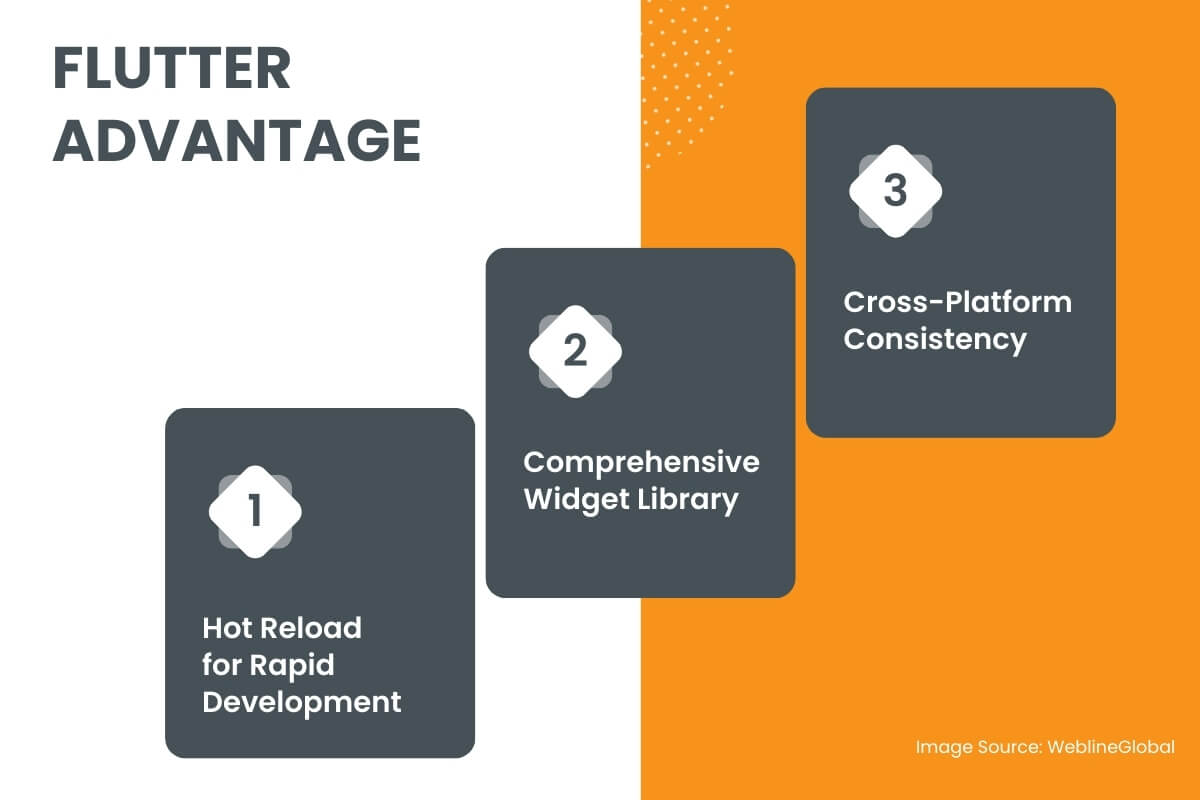
- Hot Reload for Rapid Development: Flutter’s hot reload feature allows developers to instantly see code changes, accelerating development cycles and fostering experimentation.
- Comprehensive Widget Library: Flutter provides a vast collection of pre-built widgets, enabling developers to create stunning and responsive UIs with ease.
- Cross-Platform Consistency: Flutter’s unique rendering engine ensures consistent visual experiences across different platforms, maintaining brand identity and user satisfaction.
React Native Leverages the Power of JavaScript for Mobile
React Native is backed by Facebook. It leverages the popular JavaScript library React to build cross-platform mobile apps. It offers a familiar environment for web developers venturing into mobile development.
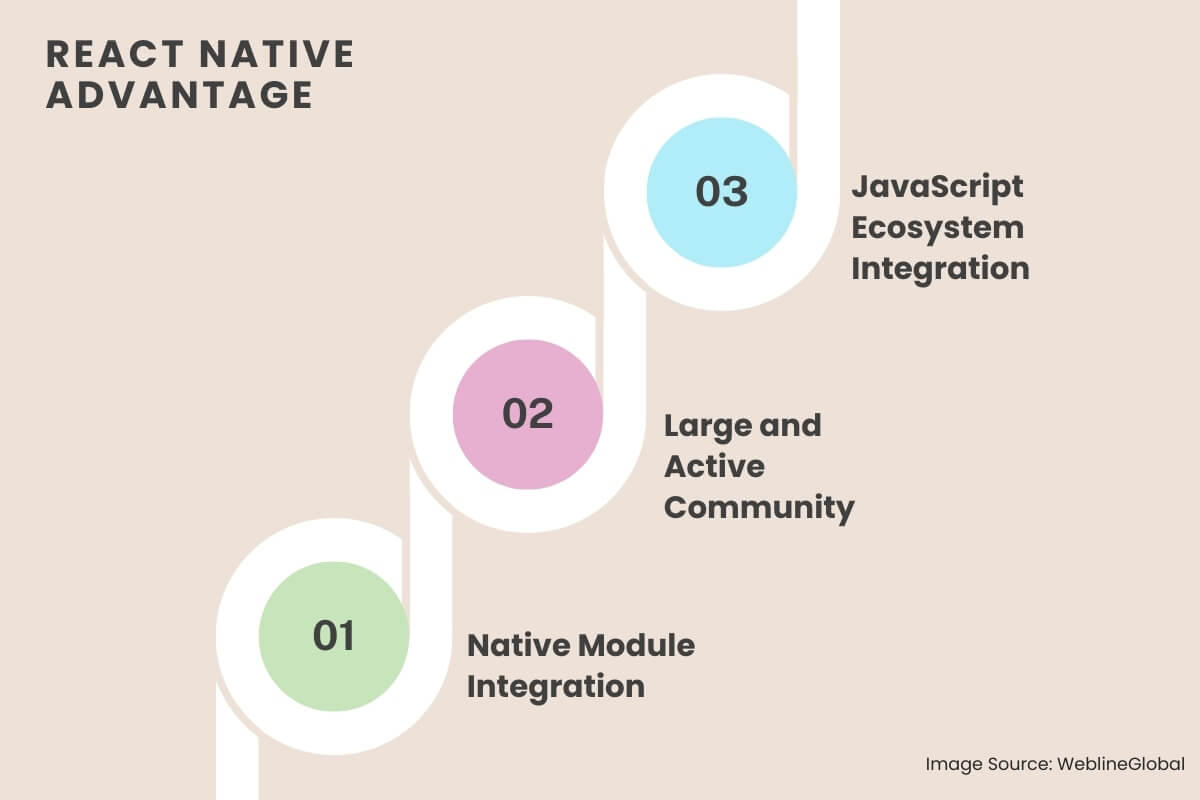
- JavaScript Ecosystem Integration: React Native seamlessly integrates with the vast JavaScript ecosystem, providing access to a wealth of libraries, tools, and resources.
- Large and Active Community: React Native boasts a thriving community, offering ample support, documentation, and resources for developers.
- Native Module Integration: React Native allows developers to integrate native modules for platform-specific functionalities, ensuring access to the full range of device capabilities.
Challenges and Considerations in Cross-Platform Development
While modern frameworks like Flutter and React Native have made significant strides in making “Build Once, Deploy Everywhere” a reality, there are still challenges and considerations that developers must keep in mind.
Platform-Specific Features
One of the biggest challenges in cross-platform development is dealing with platform-specific features. While frameworks like Flutter and React Native provide a high level of abstraction, there are still cases where developers need to write platform-specific code to access certain features or APIs.
- Native Modules: In React Native, developers may need to write native modules in Objective-C, Swift, or Java to access platform-specific features. Similarly, in Flutter, developers may need to write platform channels to communicate with native code.
- UI/UX Differences: While modern frameworks provide tools to create platform-agnostic UIs, there are still differences in UI/UX design between platforms that developers need to account for. For example, iOS and Android have different design guidelines, and developers need to ensure that their app adheres to these guidelines to provide a native feel.
Performance Considerations
While Flutter and React Native offers excellent performance, there are still cases where performance may not be on par with fully native apps. This is especially true for apps that require complex animations, heavy computations, or real-time processing.
- Optimization: Developers need to be mindful of performance optimization when building cross-platform apps. This includes minimizing the use of expensive operations, optimizing asset sizes, and using efficient algorithms.
- Testing: Rigorous testing is essential to ensure that the app performs well on all target platforms. This includes both automated testing and manual testing on real devices.
Overcoming Challenges in Cross-Platform Development
While modern frameworks have made “Build Once, Deploy Everywhere” a reality, there are still challenges that developers need to address. However, these challenges are not insurmountable. WeblineGlobal has the right approach, and we can effectively manage them all.
Addressing Platform-Specific Nuances
- Custom Plugins and Modules: In cases where platform-specific features are required, our developers create custom plugins or modules to bridge the gap. Both Flutter and React Native support this functionality.
- Adaptive UI Design: By using platform-specific design guidelines and adaptive UI components, WeblineGlobal developers ensure that their apps look and feel native on each platform.
Ensuring Optimal Performance
- Code Optimization: Our developers can optimize their code to minimize performance bottlenecks, such as reducing unnecessary computations and optimizing asset sizes.
- Rigorous Testing: Comprehensive testing on real devices is performed at WeblineGlobal to identify and resolve performance issues before deployment.
The Future of Cross-Platform Development
The future of cross-platform development is bright, with continuous advancements in frameworks like Flutter and React Native. Emerging technologies like WebAssembly, AI/ML integration, and 5G are set to further enhance the capabilities of cross-platform apps, making “Build Once, Deploy Everywhere” even more accessible.
Emerging Trends to Watch
- WebAssembly (Wasm): This technology allows developers to run high-performance code in web browsers, opening up new possibilities for cross-platform development.
- AI and Machine Learning: Integrating AI/ML into cross-platform apps can enable features like predictive analytics, natural language processing, and personalized user experiences.
- 5G and IoT: The rollout of 5G and the growth of the Internet of Things (IoT) will drive demand for cross-platform apps that can connect and interact with a wide range of devices and services.
WeblineGlobal: A Leader in Cross-Platform Development
At WeblineGlobal, the promise of “Build Once, Deploy Everywhere” is a reality. With extensive experience in cross-platform development, WeblineGlobal has leveraged the power of AI-powered Flutter and React Native to deliver high-quality applications across a wide range of platforms.
Expertise in Cross-Platform Development
WeblineGlobal understands that building high-performance, scalable apps is more than just about using the latest technologies. Hire React Native developers and Flutter developers from WeblineGlobal to ensure that your business apps not only look great but also perform flawlessly across all devices. Whether it’s for mobile, tablet, or web, WeblineGlobal ensures that the app functions as expected without compromising on user experience.
Adapting to Specific Business Needs
WeblineGlobal takes an adaptive approach to cross-platform development, understanding that each business has unique requirements. They build apps using a customized approach that ensures each platform’s specific needs are met while still using a shared core codebase. This means that clients can have the best of both worlds: a single development effort with tailored platform-specific experiences.
The Reality of ‘Build Once, Deploy Everywhere’
The myth of “Build Once, Deploy Everywhere” is no longer a myth. With the advancements in cross-platform development frameworks like Flutter and React Native, it is now possible to build apps that work across multiple platforms with minimal effort. Businesses can save time, reduce costs, and reach a broader audience without sacrificing performance or user experience by utilizing these technologies.
At WeblineGlobal, we are committed to providing you with the best mobile app development using cross-platform technology at competitive prices. We deliver innovative solutions that cater to the needs of your modern businesses in the USA. The future of mobile app development is here with WeblineGlobal, and it’s a future where “Build Once, Deploy Everywhere” is the standard, not the exception.
Social Hashtags
#CrossPlatformDevelopment #MobileAppDevelopment #FlutterDev #ReactNative #SoftwareDevelopment #TechForBusiness #NativePerformance #AppPerformance #FutureOfApps #AIinApps
Want to Reduce Development Time Without Compromising Quality?




